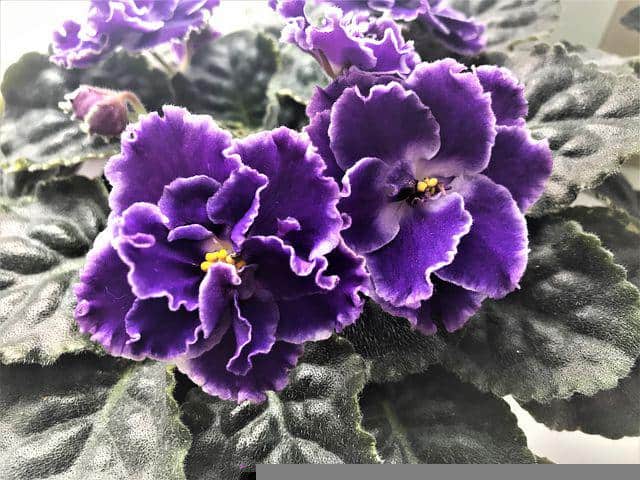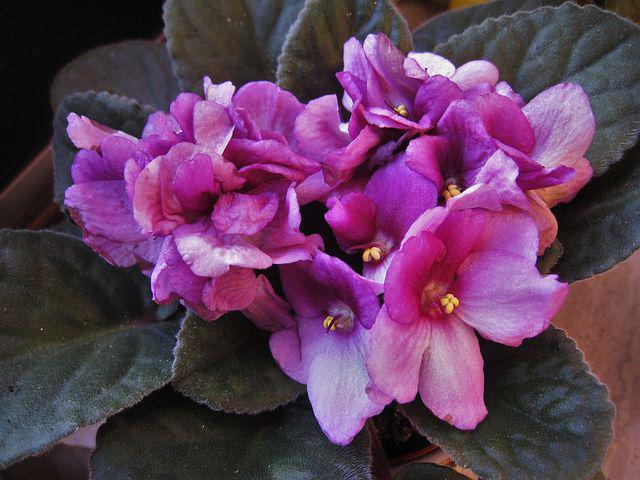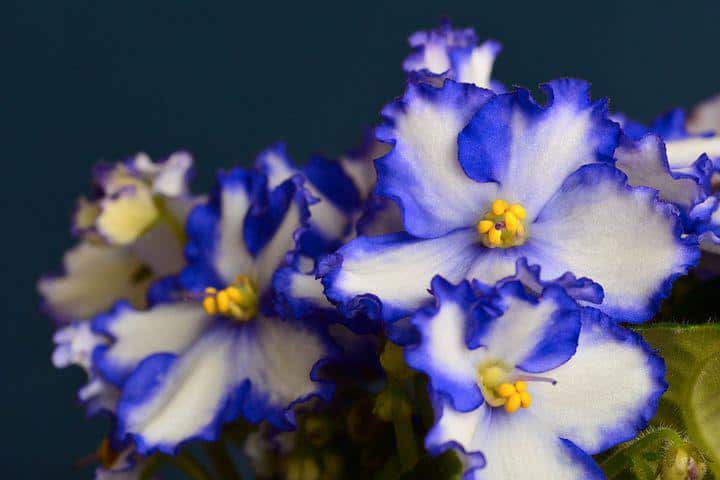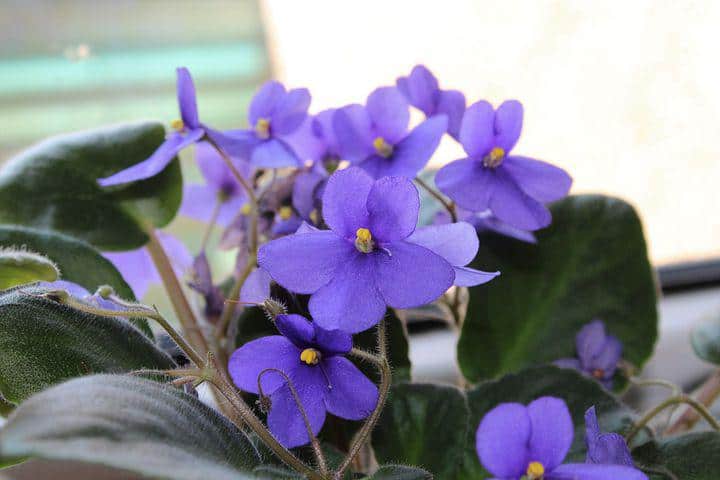Last Updated on October 3, 2023 by a Friendly Gardener
Beloved and popular as a houseplant, the African Violet is a plant that features a variety of bloom colors and foliage shapes. Slow-growing and compact it will flower more than once during the year. Supposedly a difficult plant to cultivate indoors, it will thrive when a few tips are followed.
They can bloom all year round and even reach the size of one of your dinner plates affording you a beautiful impressive indoor houseplant.
About the African Violet

This plant originates in the tropics of East Africa. Once referred to botanically as Saintpaulia, they now are known as Streptocarpus. Available in a variety of colors, they can be found with flowers in pink, red, and popular purple. The kind of flower this plant produces will also vary a bit from one cultivar to the next.
The African Violet will normally grow to a height that measures between two to four inches. But it is their spread that is so impressive, measuring from three to eight inches.
African Violet Care

The African Violet loves a bright, warm, and humid environment. Dead foliage and blooms need to be removed once they have wilted to ensure the plant’s overall health. Avoid allowing dead leaves to accumulate on the surface of the soil bed where they will rot. Plant conditions should remain damp, but with good air circulation. Exposure to bright light is crucial but not so that it damages leaf tips.
Soil
Well-draining potting soil is a must. When soil does not drain properly, root rot may develop and the soil bed and plant roots will appear soggy. Leaf drop will begin. The African Violet should never be left standing in water. You can opt to mix your own potting medium with equal parts of vermiculite, perlite, and peat moss. The soil bed pH should ideally measure between 5.8 and 6.2.
Light

The African Violet loves bright indirect sunlight as opposed to direct sunlight exposure. They can be cultivated under fluorescent lights if the grow lights are positioned twelve to fifteen inches above the plant. Direct light, from medium to bright, must always be filtered. The light directly affects flowering.
African violets that boast dark green foliage require slightly more light than cultivars with pale green or medium green foliage. Flowerpots should be turned at regular intervals to prevent blooms from reaching the same direction for light. Your Violet will be happiest and thrive with eight hours of light. If you wish to use natural light from a window, position the plant about three feet from your window. If you do not have access to this kind of light, supplement with fluorescent lighting or grow lights.
Temperature
Your Violet will thrive in an environment with a temperature of approximately 70° Fahrenheit. If the temp drops below 60° F. it may be fatal, and you will lose your plant.
Water and Humidity
A basic rule to follow when cultivating African Violets is that water should not come into contact with the foliage of this plant. Water can cause brown spots on leaves.
Keep soil moist with tepid water or slightly warm water, but not cold. This plant loves high humidity and will thrive when it has it. Always water this plant from the base or place the watering can spout into the soil directly. Water The African Violet only when the soil feels dry when touched.
Feeding
Feed your African Violet once every two weeks. Procure a fertilizer that has been formulated specifically for the African violet. The appropriate fertilizers should have a higher phosphorus content (the middle number on NPK fertilizing labels). An NPK ratio of 15-30-15 is a good option. Dilute the fertilizer to one-quarter strength when feeding during watering. When Violets do not bloom much or feature paler foliage, they may need feeding.
Pruning
Pruning will keep your plant healthy. Fingernails or fine-tipped scissors are ideal for trimming the soft stems. Remove spent flowers and damaged or dead foliage. Pruning encourages new growth and African violets can be pruned in any season.
A good pruning habit is to trim three leaves from the plant’s bottom monthly. The African violet grows new leaves regularly so do not fear trimming. Your plant will boast a better look and accord space for new growth.
Pinch off spent flowers to promote new flower growth. Remove plant material from the base but avoid cutting the plant’s stem.
Repotting

The African violet thrives more when underpotted. Repot only when necessary. If you repot, limit your new container to only one size bigger. Gently remove the entire plant and lift it out of the pot. Put the plant in the new bigger pot and fill it in with the necessary new soil.
Overcrowding in a plant’s container or leaf drop may indicate the need for repotting. Roots that peek through drainage holes or the soil bed also indicate a need for repotting.
Pests, Diseases, and Problems
Foliage problems include:
- Brown spots or stunted growth and scorching indicate sunlight is too strong.
- Leaf stalks that become leggy indicate too little light.
- Pale leaves with edges that curl indicate the temperature is too cool.
- Wilted, drooping leaves implicate underwatering or overwatering.
- White spots, blotches, or rings, indicate cold water.
- Whitish, small papery spots the sun has killed leaf cells.
Yellow leaf edges are a sign of malnutrition. Small, flattened dark leaves signal a lack of phosphate, and small yellow leaves with a hardened texture indicate nitrogen is insufficient.
A lack of flowering usually means that your plant requires more light, but a lack of humidity, cold air, and over-potting can interrupt your plant’s flowering.
African violets suffer from common houseplant pests that commonly include mealybugs, aphids, thrips, leafhoppers, and vine weevils. Organic Neem oil or insecticidal soap should be used to treat a pest-infested plant.
Diseases include powdery mildew as well as botrytis commonly called grey mold. For grey mold, remove all dead foliage and increase air ventilation in the area where your plant is.
Powdery mildew causes white dust on foliage. Good drainage and attention when feeding will help prevent this fungal infection. Fungicides can be used.
Toxicity and Pets
The ASPCA (American Society for the Prevention of Cruelty to Animals), indicates that the African violet is not toxic to dogs, or cats, and that foliage does not irritate the skin.
African Violet Propagation

The African Violet can easily be propagated using the plant’s offsets or from cuttings. Generally, mature plants produce offsets or baby plantlets at the base of the parent plant in the form of a shoot from the parent plant’s side.
They can be removed with a bit of root attached and potted separately for new plants. Removing offsets from the parent plant will also encourage the mother plant to flower more.
You can also remove healthy basal leaves from the mother plant. Prepare a pot with damp well-draining soil and position the leaf’s petiole into the soil.
Foliage can be rooted in water as an alternative. Insert a toothpick into the leaf to keep it above water. Within a few months, new leaf growth will appear, and purple blooms.
A Final Thought

The African Violet is a gorgeous houseplant that will brighten any location with colorful flowers. Because it flowers year-round, you’ll benefit from vibrant colors without any interruption from the changing seasons.
They a TLC, with filtered bright light, some humidity, warmth, watering, and the very occasional fertilization. It is the perfect plant for homes where temperatures remain constantly moderate. Your African Violet will gift you fresh flowers every day.

